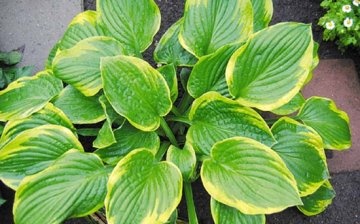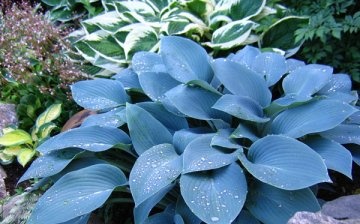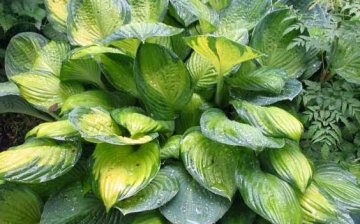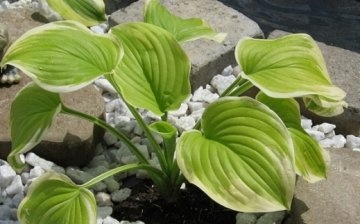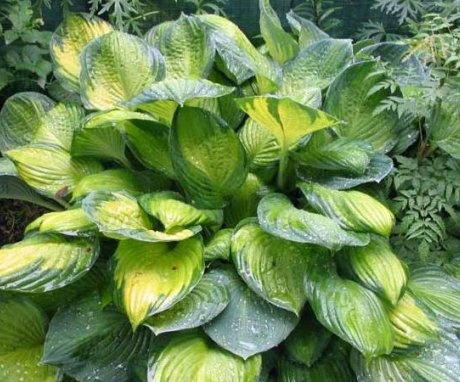Proper landing and caring for the host
A hosta flower, a photo of which makes you admire the beauty of leaves of various colors, is found in different types. As for the size, it can be either a bush less than half a meter high, or a lush meter giant.
Content:
Appearance and varieties of hosts
Hosta (Hosta) or Funkiya refers to the genus of herbaceous perennial plants of the Asparagus family. The homeland of this plant is China, Korea and Japan. Hosts interbreed easily, resulting in over 700 varieties.
Hosts are subdivided into:
- small, from 20 to 30 cm high, the main varieties that are most often grown by gardeners are:
- Abby. The leaves are round green with yellow edges;
- Alakazaam. Leaves are narrow green with creamy wavy edges;
- Allan P. Mc Connel. Heart-shaped dark green leaves with white edges;
- Bedford Rise and Shine. Shiny dark green leaves with bright yellow edges;
- Birchwood Parky's Gold. The leaves are rounded, golden in color.
- medium, 35 to 55 cm high, the most common varieties are:
- Abiqua Blue Edger. The leaves are large, blue-green;
- Adorable. Shiny with dark green leaves with a yellow center;
- Allegan Fog. Green wavy leaves with a mottled white center.
- large, from 60 to 70 cm high, the most popular varieties are:
- A Many-splendored Thing. The leaves are large, large, wrinkled in the form of waves, blue-green in color with creamy yellow edges;
- Antioch. Large, heart-shaped green leaves with creamy yellow edges, which become white over time;
- August Moon. Leaves are wrinkled, heart-shaped, yellow-green in color.
- giant, from 75 to 120 cm high, the most famous varieties are as follows:
- American Halo. The leaves are large, wrinkled, blue-green in color with cream edges;
- Blue Angel. Leaves are large blue-green;
- Blue Angel. Large leaves of blue color, which change their color in the second half of summer to dark green.
Having familiarized yourself with the types and names of varieties, their height and color, you can determine which hosta is suitable for planting in the garden.
Proper landing of hosts
Hosta loves fertile light and breathable soil. If the site has clay soil, then humus, sand and peat must be added before planting. And organic matter and clay are added to the sandy soil. If the site is swampy, then the water is removed using drainage.
The host is planted in an area that can provide her with partial shade and protection from the wind.
Landing is done as follows:
- depending on the size of the hosta, holes are dug up to a depth of 25 to 40 cm. The width of the hole also depends on the size of the plant (the hole must have a width not less than the diameter of an adult hosta during flowering);
- small hosts are planted at a distance of 15 cm from each other, medium ones - at a distance of 50 cm, large and giant ones - after 70 and 90 cm, respectively;
- if hosts for planting are purchased as a separate seedling, then before planting, the roots of the hosts are immersed in cold water for 30 minutes, after adding zircon to stimulate root formation and protect the plant from viruses;
- if the plant is bought in a container, then it is taken out of it, the roots are untangled and the hostu is placed on a mound located at the bottom of the pit, the roots are evenly spread and sprinkled with prepared soil so that the root collar is at ground level;
- after planting, the hostu is watered and mulched around the plant.
Hosta care secrets
In order for the host to have an attractive appearance, it is necessary to feed strictly three times a year. Like most garden plants, the hosta goes through three stages: vegetation, budding and flowering. Between the first two stages, you need to apply organic fertilizers in time so that the flowers of the hosta respond to such care with lush flowering.
Hosta care is not difficult. An important advantage of growing a flower is its resistance to diseases and pests. True, the hosta is susceptible to damage by slugs and snails. Timely identification of uninvited guests and their elimination protects the leaves from damage.
The host likes to be in one place, but because of the strong growth, it is advisable to divide the bush every 5 years. Division is carried out in early spring, as soon as the first shoots appear from the ground, or in autumn. The planted plants are watered regularly before they take root.
Hosta is an excellent material for landscaping. It is placed in shady and semi-shady areas of the garden, around water bodies, at the borders of lawns and lawns. A small to medium sized host serves as a wonderful curb for a garden path. Flowers in the form of bells in white, light purple and pink colors are placed on tall peduncles above dense foliage, which gives the impression of exquisite bouquets.
Compositions of hosts with aquilegia, heycheroi, astilboy, fern and other plants. Hosta with dark leaves serves as an original background for various variegated annuals.



